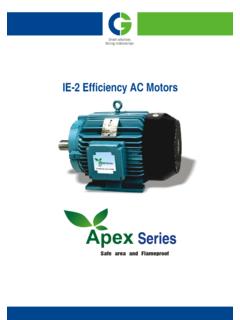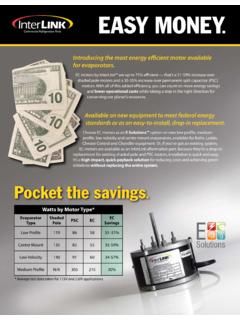Transcription of Sensorless Field Oriented Control of PMSM Motors
1 2007 Microchip Technology 1AN1078 INTRODUCTIOND esigners can expect environmental demands to con-tinue to drive the need for advanced motor Control tech-niques that produce energy efficient air conditioners,washing machines and other home appliances. Untilnow, sophisticated motor Control solutions have onlybeen available from proprietary sources. However, theimplementation of advanced, cost-effective motor con-trol algorithms is now a reality thanks to the newgeneration of Digital Signal Controllers (DSCs). An air conditioner, for example, requires fast responsefor speed changes in the motor . Advanced motor con-trol algorithms are needed to produce quieter units thatare more energy efficient. Field Oriented Control (FOC)has emerged as the leading method to achieve theseenvironmental demands. This application note discusses implementation of asensorless FOC algorithm for Permanent Magnet Syn-chronous Motors (PMSMs) using the Microchip dsPIC DSC Use the FOC Algorithm?
2 The traditional Control method for BLDC Motors drivesthe stator in a six-step process, which generates oscil-lations on the produced torque. In six-step Control , apair of windings is energized until the rotor reaches thenext position, then the motor is commutated to the nextstep. Hall sensors determine the rotor position to elec-tronically commutate the motor . Advanced sensorlessalgorithms use the back-EMF generated in the statorwinding to determine the rotor position. The dynamic response of six-step Control (also calledtrapezoidal Control ) is not suitable for washingmachines because the load is changing dynamicallywithin a wash cycle, and varies with different loads andselected wash cycle. Further, in a front load washingmachine, the gravitational power works against themotor load when the load is on the top side of the advanced algorithms such as FOC can handlethese dynamic load changes.
3 This application note focuses on the PMSM-based sen-sorless FOC Control of appliances because this controltechnique offers the greatest cost benefit in appliancemotor Control . The Sensorless FOC technique alsoovercomes restrictions placed on some applicationsthat cannot deploy position or speed sensors becausethe motor is flooded, or because of wire harness place-ment constraints. With a constant rotor magnetic fieldproduced by a permanent magnet on the rotor, thePMSM is very efficient when used in an appliance. Inaddition, its stator magnetic Field is generated by sinu-soidal distribution of windings. When compared toinduction Motors , PMSM Motors are powerful for theirsize. They are also electrically less noisy than DCmotors, since brushes are not used. Why Use Digital Signal Controllers for motor Control ?dsPIC DSCs are suitable for appliances like washingmachines and air conditioner compressors becausethey incorporate peripherals that are ideally suited formotor Control , such as: Pulse-Width Modulation (PWM) Analog-to-Digital Converters (ADCs) Quadrature Encoder Interface (QEI)When performing controller routines and implementingdigital filters, dsPIC DSCs enable designers to optimizecode because MAC instructions and fractional opera-tions can be executed in a single cycle.
4 Also, for oper-ations that require saturation capabilities, the dsPICDSCs help avoid overflows by offering hardwaresaturation need fast and flexible analog-to-digital (A/D)conversion for current sensing a crucial function inmotor Control . The dsPIC DSCs feature ADCs that canconvert input samples at 1 Msps rates, and handle upto four inputs simultaneously. Multiple trigger optionson the ADCs enable use of inexpensive current senseresistors to measure winding currents. For example,the ability to trigger A/D conversions with the PWMmodule allows inexpensive current sensing circuitry tosense inputs at specific times (switching transistorsallow current to flow through sense resistors).Author:Jorge ZambadaMicrochip Technology Field Oriented Control of PMSM MotorsAN1078DS01078A-page 2 2007 Microchip Technology Control WITH DIGITAL SIGNAL CONTROLLERSThe dsPIC30F motor Control family is specificallydesigned to Control the most popular types of Motors ,including: AC Induction Motors (ACIM) Brushed DC Motors (BDC) Brushless DC Motors (BLDC) Permanent Magnet Synchronous Motors (PMSM)Several application notes have been published basedon the dsPIC30F motor Control family (see Refer-ences Section).
5 These application notes are availableon the Microchip web site ( ).This application note demonstrates how thedsPIC30F6010A takes advantage of peripheralsspecifically suited for motor Control ( motor Control PWMand high-speed ADC) to execute Sensorless Field ori-ented Control of PMSM. The DSP engine of thedsPIC30F6010A supports the necessary fastmathematical Monitoring and Control Interface The Data Monitor and Control Interface (DMCI) pro-vides quick dynamic integration with MPLAB IDE forprojects in which operational constraints of the applica-tion depend on variable Control of range values, on/offstates or discrete values. If needed, application feed-back can be represented graphically. Examples includemotor Control and audio processing applications. The DMCI provides: 9 slider controls and 9 boolean (on/off) controls shown in Figure 1 35 input controls (see Figure 2) 4 graphs (see Figure 3)The interface provides project aware navigation of pro-gram symbols (variables) that can be dynamicallyassigned to any combination of slider, direct input orboolean controls.
6 The controls can then be used inter-actively to change values of program variables withinMPLAB IDE. The graphs can be dynamicallyconfigured for viewing program generated HighlightsThe purpose of this application note is to illustrate asoftware-based implementation of Sensorless , Field ori-ented Control for permanent magnet synchronousmotors using Microchip digital signal Control software offers these features: Implements vector Control of a Permanent Magnet Synchronous motor . Position and speed estimation algorithm eliminates the need for position sensors. An air conditioner compressor rated at kW is targeted as the main motor . The speed range is from 500 to 7300 RPM. With a 50 sec Control loop period, the software requires approximately 21 MIPS of CPU overhead (about 2/3 of the total available CPU).
7 The application requires 450 bytes of data mem-ory storage. With the user interface, approxi-mately 6 Kbytes of program memory are required. The memory requirements of the application allow it to run on the dsPIC30F2010, which is the small-est and least expensive dsPIC30F device at the time of this writing. An optional diagnostics mode can be enabled to allow real-time observation of internal program variables on an oscilloscope. This feature facilitates Control loop adjustment. This application note applies to all motor Control devices in the dsPIC30F and dsPIC33F :The characteristics of the DMCI tool aresubject to change. This description of theDMCI tool is accurate at the date ofpublication. 2007 Microchip Technology 3AN1078 FIGURE 1:DYNAMIC DATA Control INTERFACEFIGURE 2:USER-DEFINED DATA INPUT CONTROLSAN1078DS01078A-page 4 2007 Microchip Technology 3:GRAPHICAL DATA VIEW 2007 Microchip Technology 5AN1078 SYSTEM OVERVIEWAs shown in Figure 4, there are no position sensorsattached to the motor shaft.
8 Instead, low inductanceresistors, which are part of the inverter, are used forcurrent measurements on the motor . A 3-phaseinverter is used as the power stage to drive motor wind-ings. Current sensing and fault generation circuitry builtinto the power inverter protects the overall systemagainst over currents. Figure 5 shows how the 3-phase topology, as well asthe current detection and fault generation circuitry, first transistor shown on the left side of the inverteris used for Power Factor Correction (PFC), which is notpart of this application referenced in this application note is thedsPICDEM MC1 motor Control Development Board(DM300020), available at the Microchip website( ). Two power modules are avail-able: one for low voltages (up to 50V) and one for highvoltages (up to 400V). A modified High-voltage PowerModule (DM3000021) was used for this applicationnote.
9 These modules are explained in the 4:SYSTEM OVERVIEW PWM1 HPWM1 LPWM2 HPWM2 LPWM3 HPWM3 LBufferOERD113-PhaseInverterRE9AN0AN1 FLTAIaIbOver Current3-PhasePMSMS tarting Torque Demand VR1VR2 Speed DemandAN7AN2S4 Start/StopRG6RD0RD1RD2RD3 LCDDB4DB5DB6DB7 ENRSR/WRD13RC3RC1dSPIC30F6010 AFault ResetUser s InterfaceAN1078DS01078A-page 6 2007 Microchip Technology 5:3-PHASE TOPOLOGYPWM1 HPWM1 LPWM2 HPWM2 LPWM3 HPWM3L11 5/2 30 VA CPMSMM otorIaIb<CurrentLimitFaultOptional Power Factor Correction 2007 Microchip Technology 7AN1078 Field Oriented CONTROLA Matter of PerspectiveOne way to understand how FOC (sometimes referredto as vector Control ) works is to form a mental image ofthe coordinate reference transformation process. If youpicture an AC motor operation from the perspective ofthe stator, you see a sinusoidal input current applied tothe stator. This time variant signal generates a rotatingmagnetic flux.
10 The speed of the rotor is a function of therotating flux vector. From a stationary perspective, thestator currents and the rotating flux vector look like ACquantities. Now, imagine being inside the motor and runningalongside the spinning rotor at the same speed as therotating flux vector generated by the stator currents. Ifyou were to look at the motor from this perspective dur-ing steady state conditions, the stator currents look likeconstant values, and the rotating flux vector is station-ary. Ultimately, you want to Control the stator currents toobtain the desired rotor currents (which cannot bemeasured directly). With coordinate reference transfor-mation, the stator currents can be controlled like DCvalues using standard Control Control SummaryIndirect vector Control can be summarized as 3-phase stator currents are measurements provide values ia and ib.















